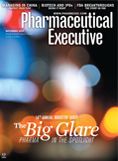Audit Alliterations
Pharmaceutical Executive
A closer look at our Industry Audit numbers hints to a clear divide between two alternative strategies for long-term growth: scale versus focus.
A ROILING STOCK MARKET is a good time to present Pharm Exec’s annual Industry Audit-now 14 years strong-on how well the biopharmaceutical business is doing on that most important performance metric for a publicly held company: delivering value to shareholders. Our diverse list of 25
William Looney

companies, ranging from big Pharma to established biotechs, as well as a few upstart, rapidly consolidating generics, leads us to a very simple conclusion. Smaller firms with a distinct customer base and a tightly focused therapeutic franchise are proving more adept at generating the organic growth-and high margins -that investors have come to expect from this industry.
A closer look at this year’s numbers suggests a clear divide between two alternative strategies for long-term growth. The first is building a business for scale and reach, seen as the best way to protect against the pricing pressures induced by payer consolidation and the cost of maintaining a competitive position across global markets. As the US health insurance sector combines to form what looks to be three market dominating giants, generic drug leaders like Teva and Mylan are bulking up to maintain their bargaining parity. The second is the drive for focus, where mid-size players like Amgen, Celgene and Novo Nordisk are rejecting the distractions of diversification in favor of a dominant role in narrow specialty classes that are a predictable draw for patients and protected behind a secure price moat.
The jury is still out on the expectation of higher-and sustained-productivity in R&D, biopharma’s biggest single source of overhead. So it is only prudent that the trending theme in this year’s Audit is the pursuit of operational excellence. The IMS Institute for Healthcare Informatics sets the challenge in stark numerical terms: to maintain current levels of profitability, the pharma majors must cut $36 billion from their sales, general and administrative (SG&A) expenses over the next two years. Our Audit metric covering SG&A performance suggests a need for urgency. SG&A spending as a percentage of sales only dipped a single percentage point-from 43% to 42%-in 2014 compared to 2013.
Strong operations management is a hedge against the possibility that payer resistance and public regulation will eventually force a decline in profit margins, still among the highest of any industry. The strategic and structural implications of a lower margin world for biopharma are significant, but manageable. In fact, the best argument for operational excellence is that it’s the one performance measure around profitability that lies within a company’s own sphere of control-actually, there is no excuse for a poor record on this score.
Our overall top performer on the Audit this year, Gilead Sciences, earned the position because of its stand out performance on every metric that relates to the efficient use of resources. Gilead’s score on Return on Asset Management is five times higher than the Audit list average, while its Profit per Employee metric is in the $2 million range, or 10 times higher than the average. More directly, Gilead’s SG&A to Sales ratio is the second best in the group, just behind the metric’s leader, Vertex.
Recognition that internal efficiencies can increase shareholder value is redefining how we assess growth in today’s biopharmaceutical industry. Growth from pile-on M&As is almost always bad, while “good” growth stems from smaller bets on narrow market segments that are price insensitive and carry an active patient voice, which creates opportunities for add-on services beyond the pill that-one day-may shine as an independent new source of revenue. The service pitch is also the driver of a more inclusive relationship with payers and customers, one that can take the industry beyond reliance on the traditional fixed, inflexible-and cost hemorrhaging-sales force.
Looking beyond the numbers, this year’s Audit reveals that revenues and profits follow from a few simple strategic drivers: offer a differentiated, patient-friendly therapy; price it high at launch; gird it with a package of services focused on achieving a measurably superior health outcome; and anticipate the inevitable cyclical downslide with payers through a relentless, long-term focus on controlling costs. There is, however, one big caveat-the inseparable link between research productivity, costs, and prices. R&D expenditures are now so high, and the proof points for approval and access so complex, that the profitability stakeholders have come to expect from biopharma depends on a single premise: premium pricing for new medicines, particularly in the US. Can it be the one metric that really counts is the unquantifiable-what we call “politics?”
William Looney is Editor-in-Chief of Pharm Exec. He can be reached at wlooney@advanstar.com. Follow Bill on Twitter: @BillPharmExec

Cell and Gene Therapy Check-in 2024
January 18th 2024Fran Gregory, VP of Emerging Therapies, Cardinal Health discusses her career, how both CAR-T therapies and personalization have been gaining momentum and what kind of progress we expect to see from them, some of the biggest hurdles facing their section of the industry, the importance of patient advocacy and so much more.
Applying Porter’s Five Forces to Portfolio Management in Pharmaceutical R&D: A Strategic Roadmap
March 17th 2025The increasing costs and complexity of R&D in the pharmaceutical industry have necessitated the adoption of strategic portfolio management to optimize resource allocation and enhance competitive advantage.